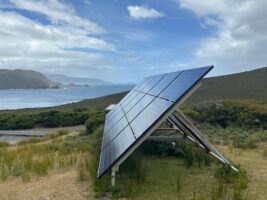Investment bank Citigroup says the return on investment for solar and battery storage by 2020 will beat the payback from solar now. That means socket parity in some countries by 2020, and utility-scale grid parity in large parts of the world by 2030. Fossil fuel generators and utiliy business models will be terminally challenged.
A major new report from researchers at investment bank Citigroup predicts that the payback for rooftop solar plus battery storage systems will, by 2020, beat the payback on solar-only systems now.
Its forecasts are based on the assumption that battery storage costs will halve over the next 5, 6 or 7 years to around $230/KWh. That would make storage financially attractive enough to increase manufacturing and further accelerate the fall in battery storage system costs towards $150/KWh.
This, in turn, will eliminate the need for subsidies, will deliver paybacks for solar plus storage of around 6-7 years in Australia and some European countries. And it will also become attractive at grid level, with solar and storage at grid parity in large parts of the world by 2030, meaning that network operators will be installing them in significant numbers.
Citigroup estimates a 240GW global market for energy storage worth more than $400 billion by that date. That is excluding car batteries.
It will, of course, have dramatic, and even terminal impacts on incumbent parts of the global energy system. A system that had been unable to store its commodity so had to build excess capacity, will now be able to calibrate supply and demand. The system is, quite literally, being turned on its head.
The Citigroup report is titled Energy Darwinism II, and is a follow-up to its original Energy Darwinism report released last year – with an Australian version this year – which discussed the potential impact of socket parity – where sourcing energy from rooftop solar in cheaper than the grid – on incumbent utilities.
Citigroup said then that the global energy mix is shifting more rapidly than is widely appreciated, and this has major implications for generators, utilities, and consumers, and for exporters of fossil fuels such as Australia.
This new report, subtitled Energy Storage: Game Changer for Utilities, Tech & Commodities is an update to take into account new forecasts on the course of battery and other forms of storage, and predicts even more dramatic impacts.
It follows a number of similar conclusions from other leading investment banks. UBS in August suggested that the payback for solar plus storage could be as low as 6 years by the end of the decade. This week, the HSBC analysis said both consumers and grid operators look to battery and other storage technologies.
Like HSBC, Citigroup says that these developments will have a dramatic impact on utilities, in some cases terminal. Generators will be most exposed, particularly coal-fired plants. Utilities will also be impacted, but have the option of buying into the technology and boosting their own regulated asset base by investing in storage.
Still, Citigroup says that most utilities are staring at the future like rabbits in the headlights, and have been slow to change despite the clear warnings.
The report quotes former US Energy Secretary Stephen Chu, who said that in his discussions with utilities their response had been any of (i) “tell us what to do”, (ii) “deer in the headlights” or (iii) “we will fight this”.
“This initially sounded like none of the utilities has in place a plan to adjust for these changes but times may be changing. Chu argues that the right business model adaptation would be for utilities to partner with installation/construction companies, use their low cost of debt to fund purchases of distributed energy capacity and storage and then rent this out to their customers.”
But back to the question of socket parity for Solar plus storage.
Figure 28 (below) illustrates Citigroup’s point. It assumes a large portion of the solar output is self-consumed rather than sold to the grid, so the ‘income’ is primarily avoided electricity bills rather than energy sales.
It assumes a $230/KWh cost for battery, a decline in installation costs of solar to €1,200/KW and unchanged household bills versus today. The implied payback period declines to 12 years and the IRR over 15 years (assuming a shortened life for batteries) rises to 5.7 per cent.
“We estimate that solar systems have already reached socket parity in most parts of Continental Europe, South West US and Australia and will do so in Japan by 2016 and in the UK and Brazil by early 2020s.
“That means that, even with no subsidies, it is economic for households in those regions to install rooftop solar.
“The introduction of battery storage in a distributed generation system would increase upfront costs for households but would improve their ongoing cash flow position as it would minimize power purchases from the grid.”
As the graph shows, the payback in Australia and some European countries will be as low six to seven years by 2020. Citigroup says this will expand and accelerate the trend of corporates and households looking to become self-sufficient.
But it’s not just at the distributed level that things will change rapidly.
That same key number – $230/kWh – will also have a big impact at utility level.
“Because, on our estimates, renewables with battery storage is due to reach grid parity in large parts of the world within 15 years, which is inside the typical 30-35- year economic lifecycle of utility assets, we concur with the conclusions reached by the Rocky Mountain Institute in its report “The Economics of Grid Defection: When and Where Distributed Solar Generation Plus Storage Competes with Traditional Utility Service” that the current business model of parts of the sector will be terminally challenged in these regions.”
Centralised power generation (coal, gas, nuclear and lignite plants) will be the first to feel the effects, with load factors falling to around 35% by 2030 across the EU-28 member states.











